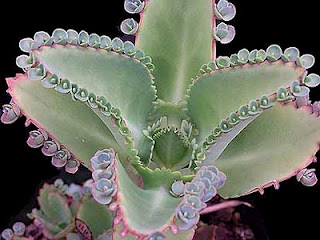Mother of Thousands - Type of Aloes
by Ms Rachel Duncan
(Champs Fleurs, Trinidad, West Indies)

Bryophyllum daigremontianum of Crassulaceae family
Mother of Thousands
Scientific Name: Bryophyllum daigremontianum
Synonym: Kalanchoe daigremontiana
Family: Crassulaceae
Frost Tolerance: Avoid frost, grows well in protected areas in Phoenix
Heat Tolerance: Very heat resistant, if in the shade
Sun Exposure: Light shade
Origin: Southwestern Madagascar (Mount Androhibolava)
Growth Habits: Annual succulent, up to 3 feet tall (90 cm), triangular leaves up to 6 inches long (15 cm)
Watering Needs: Regular water
Propagation: Offsets forming at the edge of the leaves
Ruth's response:
Thanks so much Rachel!
That's a lot of useful information about this lovely aloes plant. I've never seen one in person, so I'm especially glad you've shared a photo with us.
Say-but, those babies look like pretty little rosettes around the leaves!
I would be very pleased if others who know of various aloes types would contribute some photos and information. It would help as many visit this site in an effort to identify their own aloe, or aloe-like plants.
Blessings & Thanks,
Ruth


